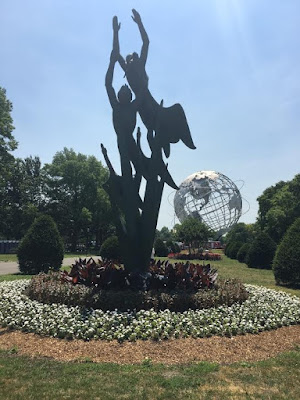Being that it’s been a month and a half since this event, I’d better stop procrastinating and get to it before my memory is old enough to qualify for a Flashback Friday post, but I had a great time at Nutley Masonic Lodge No. 25 in New Jersey on June 20. Having been invited to speak by Worshipful Master Joel (I think I’ve appeared at Nutley as a guest speaker more often than at anywhere else) in proximity to Flag Day, I presented a review of the symbolism displayed in a number of U.S. state flags. Not all 50, but about 20 of the most interesting. Needless to say several of these flags are most conspicuous to the initiated eye.
There is no reasonable claim of Freemasonry influencing these flag designs in any way, but I hoped to illustrate how instructive images Masons use are found in major and official public symbols also. I didn’t prepare much in formal remarks, so what follows are simply some notes concerning each flag.
Bro. Dave, Master of the local Rose Croix Chapter and a member of Nutley Lodge, was instrumental in bringing me back to the lectern, so of course I was sure to begin with this flag: Louisiana.
One of the alternate names of the Rose Croix Degree is Knight of the Eagle and Pelican, and one of the key symbols of the degree shows the pelican in her piety, a metaphor for love and sacrifice. For the purposes of Louisiana, the flag’s symbolism is Roman Catholic, but if you’ve read Manly Hall’s The Secret Teachings of All Ages you probably recall the above illustration, a full-page, by Augustus Knapp, showing the full Rose Croix imagery.
Utah – The Beehive is one of my favorite Masonic symbols, and it is not uniquely Masonic. It is widely understood as a symbol of industry, but considering Freemasonry’s significance to Mormonism, which begat the State of Utah, it is an apt choice for the flag.
Alabama – St. Andrew’s Cross: St. Andrew is the patron saint of Scottish Freemasonry. This X-shape is the cross on which Andrew was crucified.
Alaska – Astronomy: the North Star and the Big Dipper.
Arizona – “As the sun rises in the East,” or sets in the West as the case may be. Thirteen rays = the original states. The colors are from the flag of Spain. The star symbolizes the copper mining industry.
Maine – We see the North Star again. “Dirigo” means “I lead.” For the Masonic eye, we have the anchor at right. The symbol of Hope.
New Jersey! – Liberty holds a staff topped with the red cap. This hat was presented to freed Roman slaves, and it appears in several state flags. The shield shows three plows to symbolize the agriculture of the Garden State. At right is the ancient goddess Ceres (grain) holding none other than the cornucopia.
New Mexico – Sometimes simple is best. What we have here is another sun symbol. There are four angles of a square. Four parts of a circle. This is a sacred symbol of the Zia tribe of Native Americans. Four is the sacred number denoting the circle of life; the four cardinal directions; four seasons; four elements.
New York – Another radiant sun. Justice stands at right with the scales—another Scottish Rite symbol. There’s that Roman slave cap again at left. The body of water is the mighty Hudson River.
Oklahoma – I included this because it has a smoking pipe. Lots of Native American symbolism built into this. That’s an olive branch.
Rhode Island – The anchor of Hope most prominently.
Virginia – Left breast bared! This is Virtus, goddess of virtue. Sic Semper Tyrannis means Thus Always to Tyrants—what John Wilkes Booth shouted after shooting President Lincoln. This was designed by George Wythe, a signer of the Declaration of Independence, but not a Freemason.
Washington, DC – Taken from the coat of arms of the Washington family–not just George Washington, but his ancestors dating to the 12th century. Benjamin Franklin said this emblem partially inspired the look of the U.S. flag. It also appears on the Purple Heart.
 |
| Magpie file photo |
West Virginia – The Latin motto means “Mountaineers are always free.” On top of the crossed rifles is that slave’s red cap again. To the left we see an ear of corn and also a bushel of wheat. June 20 is today: the anniversary of the state’s admission to the Union.
Wisconsin – Masonic symbols: the anchor, the cornucopia, the spade & pickaxe, as in Royal Arch Masonry.
Flag images courtesy united-states-flag.com










































































































